How to Help Clients Training for a Triathlon (Free Guide)
Learning how to guide clients training for a triathlon can significantly enhance your client base as a personal trainer. But, it’s important that you have the right tools and knowledge to guide these clients effectively. Utilizing certain features of personal training software can help you in this endeavor. Discover how to guide clients training for a triathlon and what tools you’ll need in this detailed guide.
- Assisting clients in triathlon training demands a balanced approach that integrates swimming, cycling, and running workouts, along with strength and flexibility exercises.
- Most triathlon training clients will benefit from a structured training plan that gradually increases their endurance in each discipline, while also incorporating recovery and cross-training to avoid overuse injuries.
- Incorporating workout and assessment software can help in tracking progress, scheduling workouts, and managing recovery, ensuring your clients reach their triathlon goals safely and effectively.
Guiding clients towards their triathlon goals can provide personal trainers a fulfilling avenue to make a substantial impact on their clients’ fitness journeys.
To help clients training for a triathlon effectively, you not only need an understanding of endurance training across multiple disciplines but also the right tools to monitor progress and adjust training plans; that’s where personal training software becomes essential. By leveraging the features offered by the best online personal training software, you can guide clients in their triathlon training in a way that maximizes their performance and minimizes injury risk.
To get the best personal training software from Exercise.com, book a demo now!
The Benefits of Triathlon Training
Triathlon training is a demanding endeavor that requires a comprehensive approach to prepare athletes for the physical and mental challenges they will face during the race. As a fitness trainer or coach, your role is crucial in helping your clients achieve their goals and perform at their best on race day. In this article, we will explore the various aspects of triathlon training and provide you with valuable insights to effectively assist your clients in their journey towards triathlon success.
Engaging in triathlon training offers numerous benefits to both novice and experienced athletes. First and foremost, it is a highly effective way to improve overall fitness. Triathlon encompasses three disciplines – swimming, cycling, and running – which work different muscle groups and provide a full-body workout. This variety not only enhances strength and endurance but also promotes cardiovascular health and boosts metabolic efficiency.
Additionally, triathlon training challenges athletes mentally, as they must learn to manage their thoughts and maintain focus throughout each discipline. The race itself becomes an opportunity for personal growth and self-discovery, as individuals push their boundaries and overcome obstacles.
Another benefit of triathlon training is the opportunity for social interaction and community building. Triathlon events often attract a diverse group of participants, creating a supportive and inclusive environment. Athletes can connect with like-minded individuals, share training tips, and form lasting friendships. The sense of camaraderie and teamwork during races can also be incredibly motivating and inspiring.
Furthermore, triathlon training can have a positive impact on mental health. Engaging in regular physical activity, such as swimming, cycling, and running, has been shown to reduce symptoms of stress, anxiety, and depression. The endorphins released during exercise can improve mood and overall well-being. Additionally, setting and achieving goals in triathlon training can boost self-confidence and provide a sense of accomplishment.
Read More:
- How to Help Clients Training for a Marathon
- How to Help Clients Training for a 5K
- How to Help Clients Training for a Track Meet
Choosing the Right Training Program for Your Clients
When it comes to selecting a training program for your clients, it is essential to consider their individual goals, fitness level, and time availability. Tailoring a program that meets their specific needs will optimize their progress and minimize the risk of injury.
Ensure that the program includes a mix of endurance-building exercises, interval training, strength and conditioning workouts, and rest days for recovery. It is also beneficial to incorporate cross-training activities to prevent overuse injuries and create a well-rounded athlete.
Additionally, it is important to regularly assess and reassess your clients’ progress and adjust their training program accordingly. This will ensure that they continue to challenge themselves and make consistent improvements.
Furthermore, don’t forget to educate your clients about the importance of proper nutrition and hydration to support their training efforts. A well-balanced diet and adequate hydration are crucial for fueling workouts, promoting muscle recovery, and optimizing overall performance.
Setting Realistic Goals for Triathlon Training
Setting achievable goals is crucial to keep your clients motivated and committed throughout their training journey. Begin by assessing their current fitness level and discuss their aspirations for the race. Emphasize the importance of setting both short-term and long-term goals that are measurable, realistic, and time-bound.
Encourage your clients to break their larger goal of completing a triathlon into smaller milestones. This approach allows them to track their progress and celebrate achievements along the way, enhancing their confidence and sense of accomplishment.
Another important aspect of setting realistic goals for triathlon training is considering the individual’s time availability and other commitments. It is essential to help your clients create a training plan that fits into their schedule and takes into account their work, family, and personal life. By doing so, they will be more likely to stick to their training routine and avoid feeling overwhelmed or discouraged.
In addition to setting goals related to physical performance, it is also important to encourage your clients to set goals related to mental and emotional well-being. Triathlon training can be physically demanding and mentally challenging, so it is crucial to help your clients develop strategies to stay motivated, manage stress, and maintain a positive mindset throughout their training journey. This could include incorporating mindfulness practices, visualization techniques, or seeking support from a sports psychologist or mental health professional.
Creating a Balanced Training Schedule
A well-structured training schedule is a key component of successful triathlon preparation. Help your clients create a plan that balances their training sessions across swimming, cycling, and running, while also considering their other commitments and recovery needs.
Ensure that the schedule includes dedicated time for each discipline, as well as rest days and active recovery exercises. Emphasize the significance of progressive overload, gradually increasing the training volume and intensity to facilitate adaptation and avoid overtraining.
The Importance of Proper Nutrition for Triathletes
Nutrition plays a vital role in supporting optimal performance and recovery during triathlon training. Educate your clients about the importance of consuming a well-balanced diet that includes ample carbohydrates, healthy fats, and lean proteins.
Advise them to focus on fueling their bodies before, during, and after workouts, providing the necessary energy and nutrients. Encourage them to hydrate adequately, both during training sessions and throughout the day, to maintain optimal performance and prevent dehydration.
Effective Cross-Training Exercises for Triathlon Preparation
Cross-training is a valuable approach to enhance overall fitness and prevent overuse injuries. Incorporate exercises such as yoga, strength training, and Pilates into your clients’ training programs to improve flexibility, build strength, and enhance core stability.
These activities not only complement the swim, bike, and run disciplines but also help address muscle imbalances and strengthen weak areas to prevent injuries. Emphasize the importance of technique and form during cross-training exercises to maximize their benefits.
Building Endurance and Stamina Through Swim Training
Swimming is often a discipline that presents challenges for many triathletes. Help your clients build endurance and stamina by incorporating interval training into their swim sessions.
Encourage them to gradually increase both their distance and speed, alternating between swim strokes and incorporating drills to improve technique. Provide feedback and offer guidance on proper breathing techniques, body alignment, and efficient stroke mechanics to optimize their performance in the water.
Developing Strength and Power with Cycling Workouts
Cycling training is crucial to build leg strength and cardiovascular endurance. Guide your clients through interval training sessions, hill repeats, and long-distance rides to enhance their cycling performance.
Teach them proper bike handling skills, gear selection, and pacing strategies. Emphasize the importance of maintaining a balanced effort throughout the ride and provide guidance on maintaining the correct cycling position to prevent discomfort and injury.
Improving Speed and Agility with Running Drills
Running is the final discipline of a triathlon, and it requires a combination of speed, agility, and endurance. Incorporate running drills into your clients’ training programs to improve their running form, stride efficiency, and overall speed.
Include interval training sessions, tempo runs, and hill repeats to challenge their cardiovascular system and build muscular strength. Teach them proper warm-up and cool-down routines, as well as stretching exercises to prevent injuries and enhance recovery.
Incorporating Brick Workouts into Triathlon Training
Brick workouts, a term commonly used in triathlon training, involve practicing the transition between two disciplines. Typically, this refers to a bike-run combination, as transitioning from cycling to running can be challenging for many athletes.
Include brick workouts in your clients’ training plans to familiarize them with the sensations of transitioning from one discipline to another. Start with short bike-to-run intervals and gradually increase the duration. Guide them on pacing strategies and mental preparation techniques to effectively manage the transition during actual races.
Common Mistakes to Avoid in Triathlon Training
Throughout their training journey, your clients may encounter common mistakes that can hinder their progress or increase the risk of injury. Educate them about these pitfalls and provide them with guidance to avoid them.
Emphasize the importance of proper rest and recovery, maintaining a balanced and gradual increase in training volume, and listening to their bodies to prevent overuse injuries. Advise them to avoid excessive comparison with others and set realistic expectations to maintain a positive mindset throughout their training experience.
Preventing and Managing Injuries during Triathlon Preparation
Injury prevention is essential in any sports training, and triathlon is no exception. Teach your clients about the importance of proper warm-up, cool-down, and stretching routines to prepare their bodies for training sessions and facilitate recovery.
Advise them to listen to their bodies and address any discomfort or pain promptly. Encourage them to cross-train and focus on building functional strength to prevent muscle imbalances. If an injury does occur, guide them on appropriate rehabilitation exercises, and recommend seeking medical attention if necessary.
Mental Preparation and Motivation Techniques for Triathletes
Mental fortitude is a critical aspect of triathlon training and racing. Help your clients develop techniques to manage pre-race nerves, maintain focus during training sessions, and stay motivated throughout their journey.
Introduce visualization exercises, positive self-talk, and goal-setting strategies to enhance their mental preparation. Encourage them to communicate their fears and concerns, providing emotional support and guidance to build their confidence and resilience.
Tracking Progress and Adjusting Training Plans as Needed
Regularly monitoring your clients’ progress is crucial to evaluate the effectiveness of their training program and make necessary adjustments. Educate them on various methods to track their performance, such as using training logs, wearable devices, or mobile applications.
Use this data to analyze their strengths and weaknesses, identify areas for improvement, and adjust their training plans accordingly. Emphasize the importance of staying flexible and adapting the program to their individual needs, taking into account their lifestyle, stress levels, and unforeseen circumstances.
Strategies for a Successful Transition from One Discipline to Another
The transitions between each discipline in a triathlon can greatly impact an athlete’s overall race performance. Guide your clients on strategies to effectively manage these transitions and minimize time loss.
Practice transition routines during training, including changing gear, nutrition strategies, and mental preparation techniques. Encourage them to visualize the transition process and rehearse it multiple times before race day. Emphasize the importance of staying calm and focused, maintaining a systematic approach to ensure a smooth transition.
Tips for Efficient Transitions during Triathlon Races
During triathlon races, every second counts. Share valuable tips with your clients to optimize their transition times and gain a competitive edge.
Advise them to set up their transition area in an organized manner beforehand, practice mounting and dismounting their bike smoothly, and efficiently switch between different equipment and apparel. Encourage them to practice running in their cycling shoes to reduce transition times between the bike and run disciplines.
Preparing Clients for Open Water Swimming Challenges in Triathlons
Open water swimming can be a significant source of anxiety and pose unique challenges in triathlon races. Be sure to prepare your clients for these conditions and provide them with strategies to overcome potential difficulties.
Incorporate open water swim practices into their training program to familiarize them with different environments and water conditions. Teach them techniques such as sighting and drafting to navigate more efficiently. Stress the importance of remaining calm, focusing on their breathing, and conserving energy during open water swims.
Strategies for Tackling Hill Climbs on the Bike Leg of a Triathlon
Hill climbs can be physically and mentally daunting for many triathletes. Equip your clients with strategies to conquer hills efficiently and maintain their momentum throughout the bike leg.
Teach them proper body positioning when climbing, emphasizing the use of lower gears, pacing themselves, and maintaining a consistent effort. Provide guidance on shifting techniques to optimize power and reduce energy expenditure. Encourage them to incorporate hill-specific training sessions into their program to build strength and confidence on uphill sections.
Maintaining Energy Levels and Hydration during Long-Distance Events
Long-distance triathlons demand careful attention to nutrition, hydration, and energy management. Educate your clients on strategies to sustain their energy levels and maintain proper hydration during these endurance events.
Advise them to practice their race nutrition and hydration plan during training to identify the optimal intake and timing. Emphasize the importance of consuming easily digestible carbohydrates, electrolytes, and fluids throughout the race. Encourage them to listen to their bodies, stay consistent with their plan, and adapt based on changing conditions.
Helping clients train for a triathlon requires a comprehensive approach that encompasses physical conditioning, mental preparation, and strategic race execution. By considering all aspects of triathlon training, from setting goals and nutrition to addressing common mistakes and injury prevention, you can guide your clients towards success on race day. Empower them with knowledge, support, and tailored training programs to maximize their potential and enjoy the transformative journey of triathlon training.
How do you plan a triathlon training?
Planning a triathlon training involves setting goals, creating a training schedule, and incorporating different types of workouts for swimming, cycling, and running. Start by determining the distance and date of your target triathlon, then establish a training timeline that gradually increases in intensity and duration. Consider your current fitness level, time availability, and any specific weaknesses or areas for improvement. Balance your training with a mix of endurance workouts, speed and interval sessions, strength training, and recovery days to optimize performance and reduce the risk of injury.
How do you start strength training for a triathlon?
To start strength training for a triathlon, focus on exercises that target the major muscle groups used in swimming, cycling, and running. Incorporate exercises such as squats, lunges, deadlifts, push-ups, pull-ups, planks, and core exercises. Begin with lighter weights or bodyweight exercises and gradually increase intensity and resistance as you build strength and confidence. Aim to include strength training sessions 2-3 times per week, focusing on proper form and technique.
Can a peloton help you train for a triathlon?
Using a Peloton bike can be a helpful tool for triathlon training, especially for indoor cycling workouts. The Peloton platform offers a variety of cycling classes and programs that can improve cardiovascular fitness, build leg strength, and enhance your cycling performance. While it can be a valuable training tool, it’s important to supplement your Peloton rides with outdoor cycling to simulate race conditions and practice bike handling skills.
How do you build endurance for a triathlon?
To build endurance for a triathlon, gradually increase the duration and intensity of your training sessions over time. Incorporate long, slow distance workouts in each discipline (swim, bike, run) to build stamina and aerobic capacity. Include interval training sessions to improve your body’s ability to sustain higher intensities. Gradually increase the total training volume each week, ensuring proper rest and recovery days to avoid overtraining. Consistency is key when building endurance, so aim for regular training sessions to allow your body to adapt and improve.
What is the couch to triathlon training plan?
The “Couch to Triathlon” training plan is a beginner-friendly program that helps individuals gradually progress from a sedentary lifestyle to completing a triathlon. It typically involves a structured training schedule that gradually increases training volume and intensity over several weeks or months. The plan includes a combination of swimming, cycling, and running workouts, starting with shorter distances and gradually building up to race-specific distances. The Couch to Triathlon training plan is designed to provide a systematic approach for beginners to safely and effectively prepare for their first triathlon.
How do you structure a triathlon season?
Structuring a triathlon season involves planning and organizing your training and races to align with your goals and peak performance. Start by identifying your target races and prioritize them based on their importance and timing. Determine your training phases, including base building, specific preparation, and tapering periods. Allocate specific blocks of time for each discipline (swim, bike, run) and consider incorporating recovery weeks to prevent overtraining. Plan race-specific workouts and simulations to prepare for the demands of each triathlon distance. Adjust your training schedule as needed based on feedback from training sessions and races.
Should I lift weights while training for a triathlon?
Lifting weights can be beneficial for triathlon training, as it helps improve strength, power, and overall athletic performance. Strength training can enhance muscular endurance, increase bone density, and reduce the risk of injuries. Focus on exercises that target the major muscle groups used in swimming, cycling, and running, and incorporate both compound and functional movements. Aim to include 2-3 strength training sessions per week, with a focus on proper form, progressive overload, and periodization to align with your triathlon training goals.
How much strength training should a triathlete do?
The amount of strength training for a triathlete can vary based on individual goals, training volume, and other factors. Generally, 2-3 strength training sessions per week lasting 30-60 minutes each can be effective. Focus on exercises that improve functional strength, muscular endurance, and core stability. Include exercises targeting major muscle groups, such as squats, lunges, deadlifts, push-ups, pull-ups, and planks. Consider working with a strength training coach or a certified personal trainer to create a program tailored to your specific needs and goals.
Can you train for a triathlon on a treadmill?
While training for a triathlon on a treadmill is possible, it is recommended to incorporate outdoor training as well, especially for cycling and running. Treadmill training can be used for specific workouts such as interval training, tempo runs, or hill repeats. It provides a controlled environment for consistent pacing and incline adjustments. However, to fully simulate race conditions and develop skills like bike handling, running on varied terrain, and open water swimming, incorporating outdoor training is essential.
Can you build muscle and train for a triathlon?
Building muscle while training for a triathlon is possible, but it requires balancing your training priorities. Triathlon training typically emphasizes cardiovascular endurance and overall fitness rather than focusing solely on muscle hypertrophy. However, including strength training exercises that target major muscle groups can help maintain and develop muscular strength and power. Proper nutrition, including adequate protein intake, is essential for muscle recovery and growth. It’s important to find the right balance between endurance training and strength training to optimize performance and avoid excessive muscle fatigue.
How many miles do you have to bike in a triathlon?
The biking distance in a triathlon varies depending on the specific race distance. The most common triathlon distances are sprint, Olympic, half Ironman, and Ironman. The biking portion for each distance typically ranges from 12 to 112 miles. For example, in an Olympic-distance triathlon, the bike leg is typically 40 kilometers (24.8 miles). It’s important to review the race details of the specific triathlon you are participating in to know the exact biking distance.
How many hours a day should I train for a triathlon?
The number of training hours per day for a triathlon can vary based on your fitness level, goals, and available time. Generally, triathlon training involves 5-6 days of training per week, with each session lasting anywhere from 45 minutes to 2 hours or more, depending on the training phase and intensity. As you progress and increase the training volume, it’s common to have longer sessions, especially for the bike and run disciplines. It’s important to balance your training with rest and recovery days to avoid overtraining and promote proper adaptation.
How do you pace yourself in a triathlon?
Pacing yourself in a triathlon is crucial to ensure you have enough energy to complete the entire race. It involves finding a sustainable effort level that allows you to maintain a consistent pace throughout each discipline. Practice pacing in training by using a heart rate monitor, perceived exertion, or pacing strategies based on predetermined race goals. Focus on starting conservatively, especially in longer distances, and gradually increase your effort as the race progresses. Learning to manage your energy and effort levels will help you avoid fatigue and improve your overall performance.
How many hours a week do triathletes train?
The number of training hours per week for triathletes can vary depending on the individual’s fitness level, experience, and race goals. Elite and professional triathletes may train upwards of 20-30 hours per week or more. For age-group triathletes, the average training volume may range from 8 to 15 hours per week, depending on the race distance and training phase. It’s important to find a training volume that suits your lifestyle, allows for adequate recovery, and helps you progress towards your specific triathlon goals. Quality workouts, consistency, and appropriate recovery are key factors in maximizing training adaptations.
Use the Best Personal Training Software to Offer a Stellar Client Experience
Training clients for a triathlon race requires a comprehensive and tailored approach. See how Exercise.com can help.

To learn more about how Exercise.com can help you run your fitness business, book a demo now!
Creating Training Plans for Clients Who Want to Compete in a Triathlon
Here’s how you can help your clients accomplish their goals by using workout plan creator software to create workout plans, run fitness challenges, offer online workout groups, message clients, and more, all from your very own custom branded fitness apps.
Exercise.com stands out as an all-in-one fitness business management software with comprehensive workout plan sales capabilities. The robust member management, billing & invoicing, and unique fitness assessment tools offer a one-stop solution for fitness business needs. Here’s just some of what you can do with the Exercise.com platform:
Engage with clients via automations.
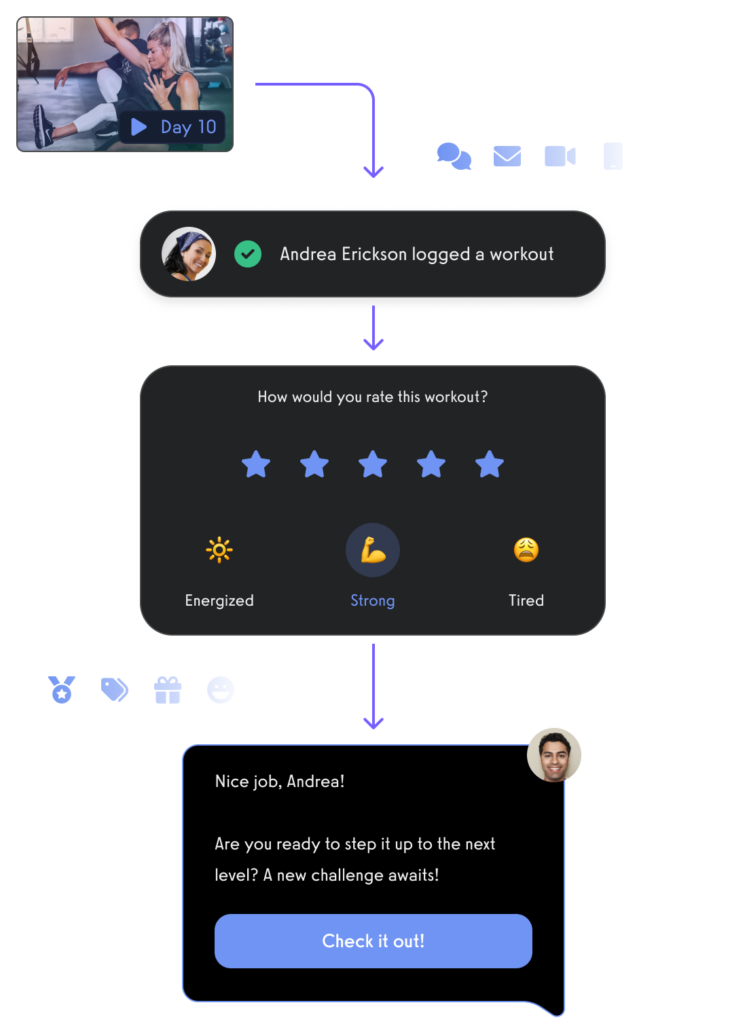
Manage leads with a fitness CRM. Read More: Compare Gym CRM Software Online
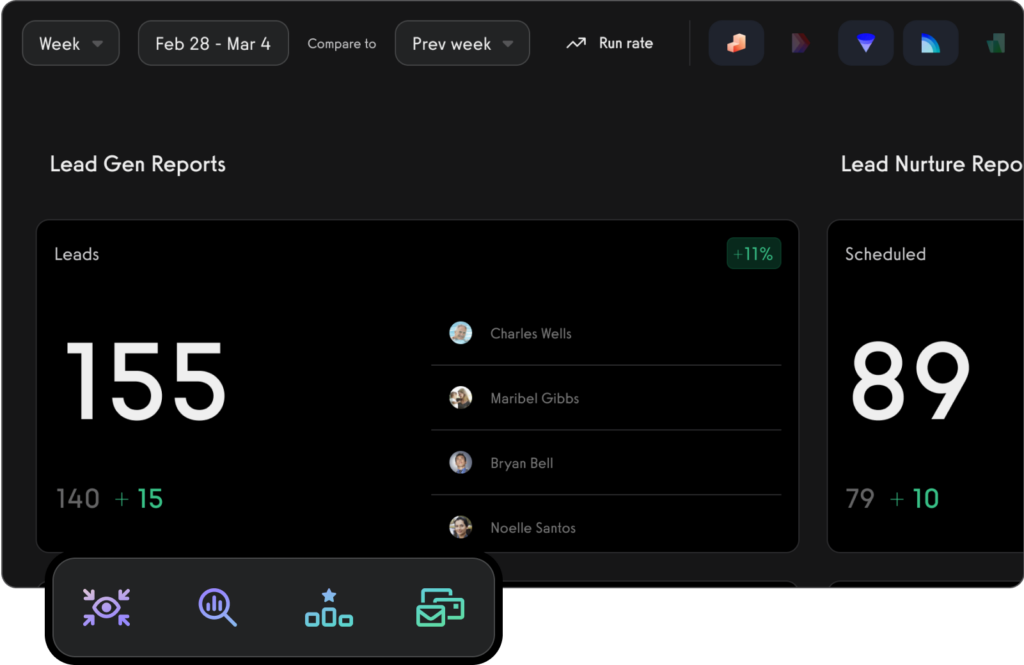
Create and send fitness assessments with ease.
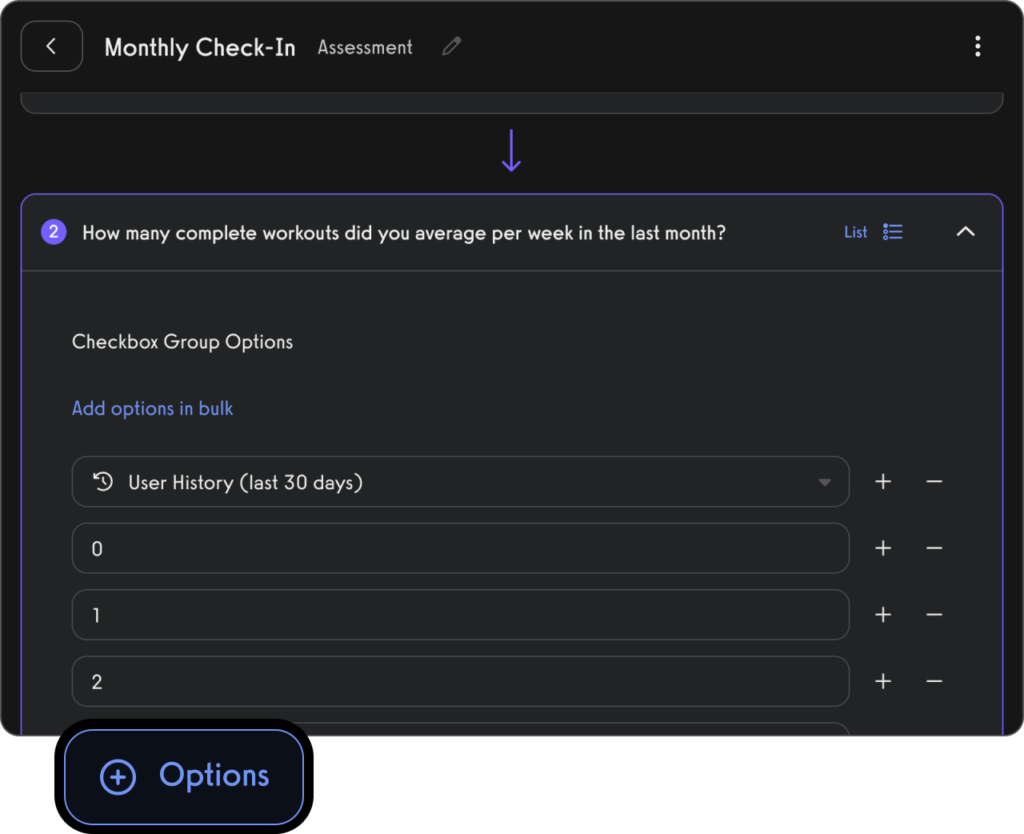
Use fitness habit tracking to inspire and motivate personal training clients (in-person and remote).

Use fitness progress photos to engage with clients.
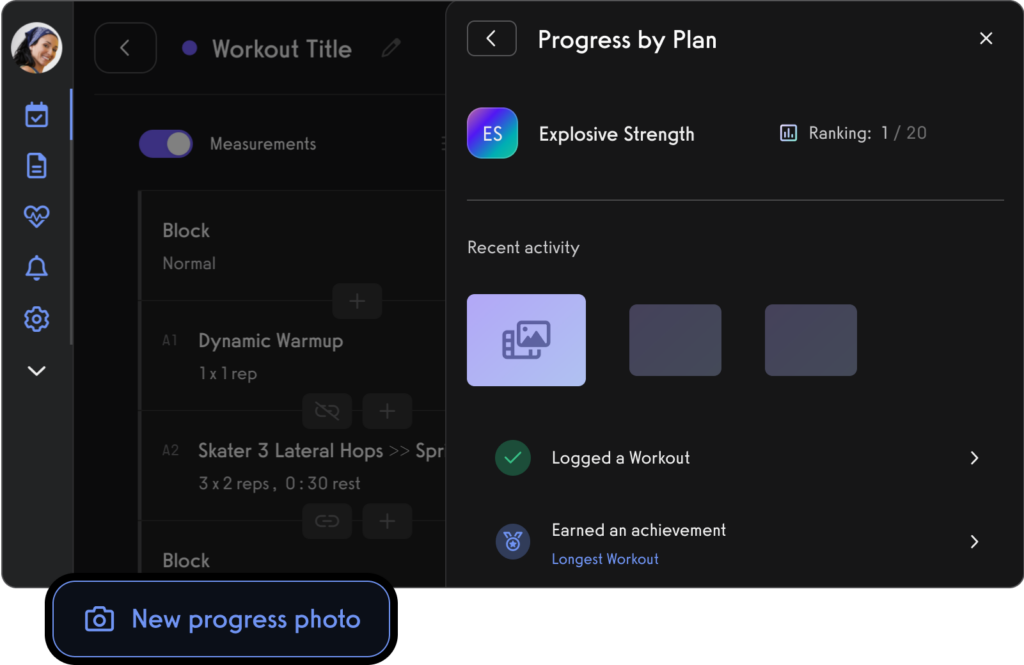
Use fitness leaderboards to track performance and inspire healthy competition.
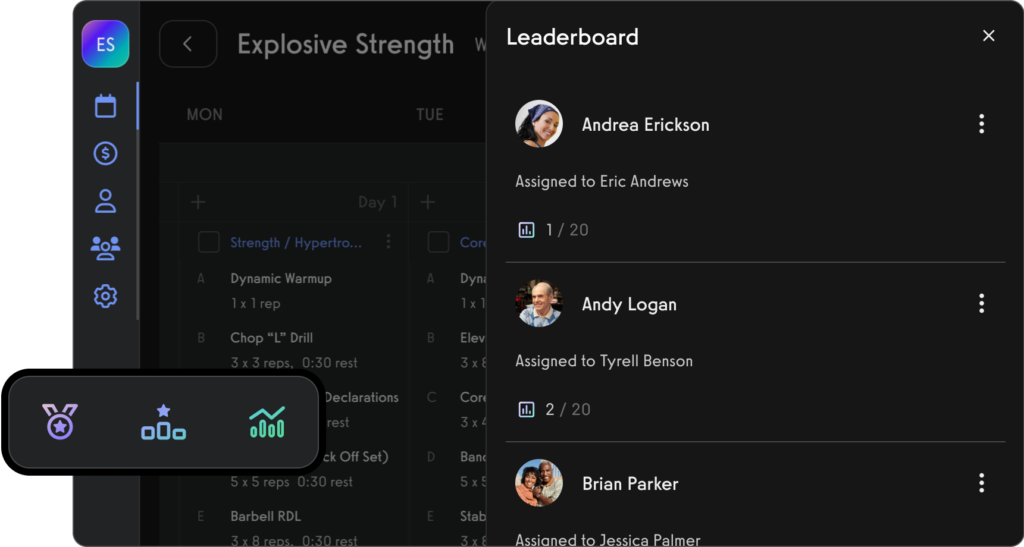
Use the exercise demonstration video library or create your own custom exercise demonstration videos.

Create workout plans for parents and dependents, teams and more.

Manage personal training clients with ease.

Book appointments for clients (Read More: Best Gym Booking Software)

Create classes and fitness groups

Manage fitness challenges (Read More: 100+ Fitness Challenge Ideas)
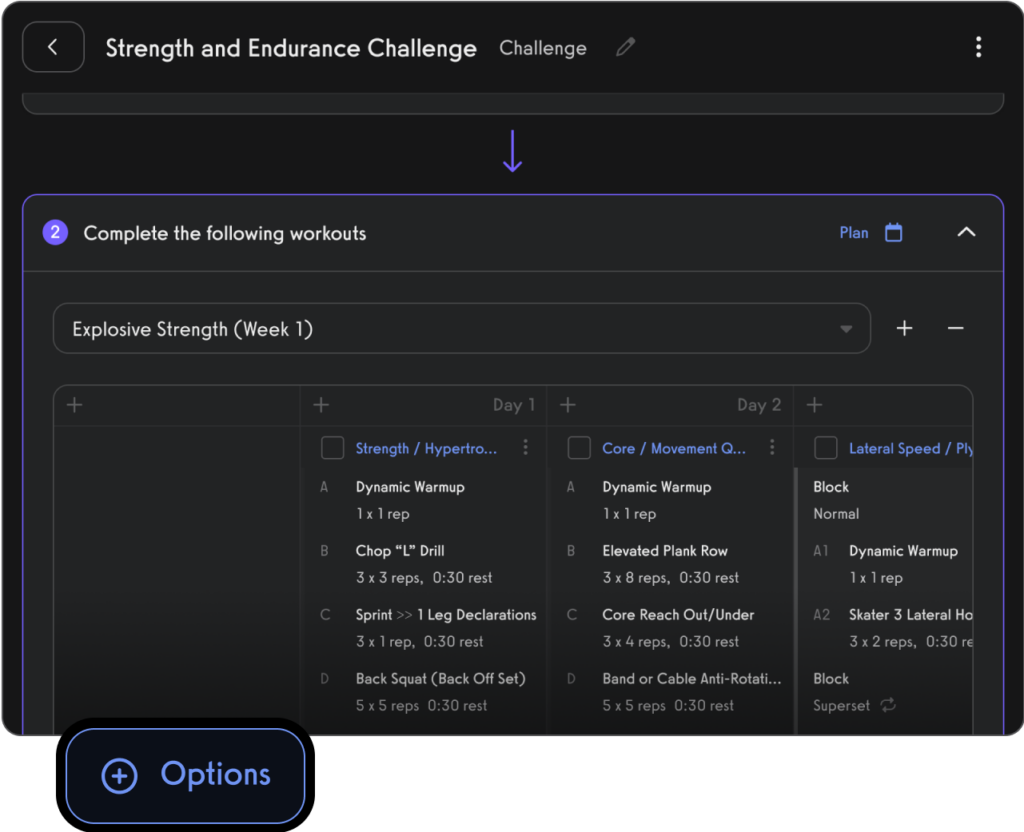
Process payments for open gym, classes, and personal training.

Communicate with gym members, athletes, team members, personal training clients, class members, parents, and dependents via SMS, email, and in-app push notification.
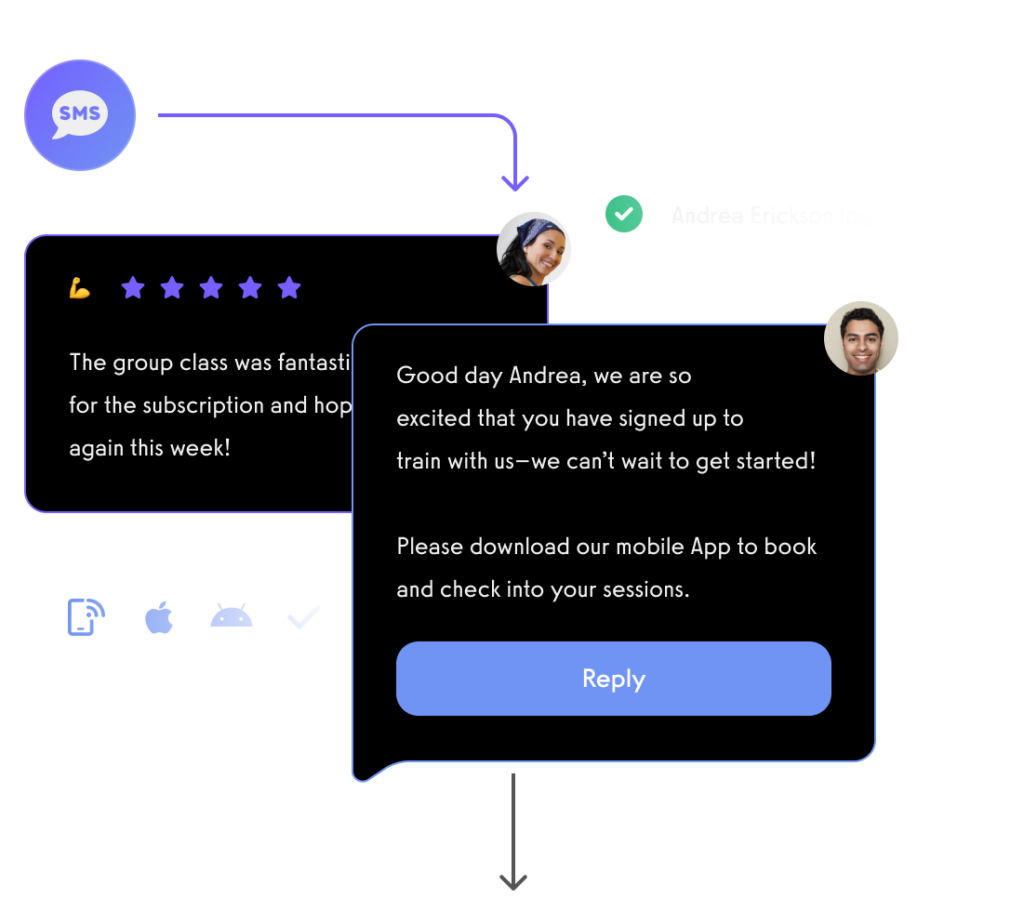
View performance over time, track personal records, and other fitness stats with performance reporting dashboards.
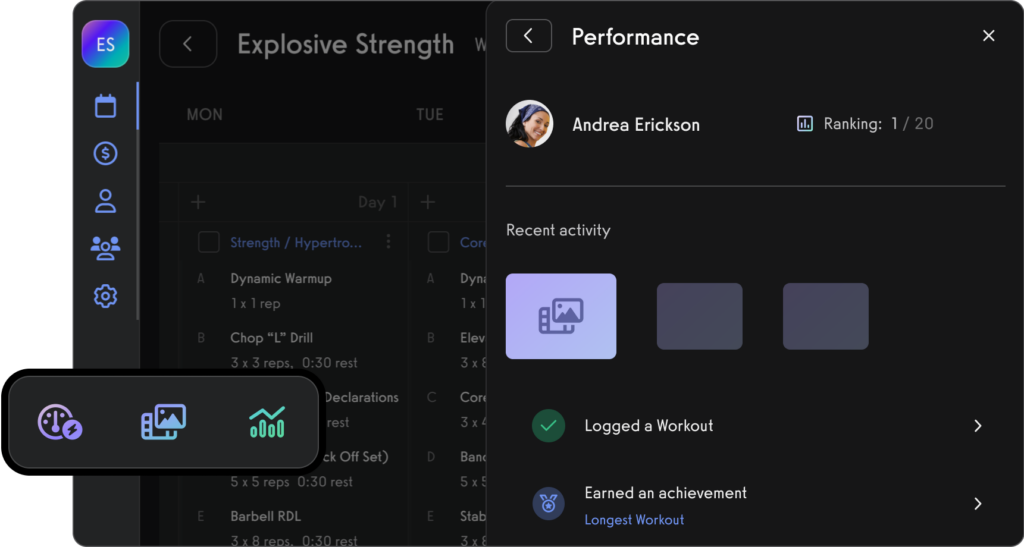
And of course, view all of your fitness business reports easily too.

All from your custom-branded fitness apps (Read More: Best Gym Mobile Fitness Apps Software)

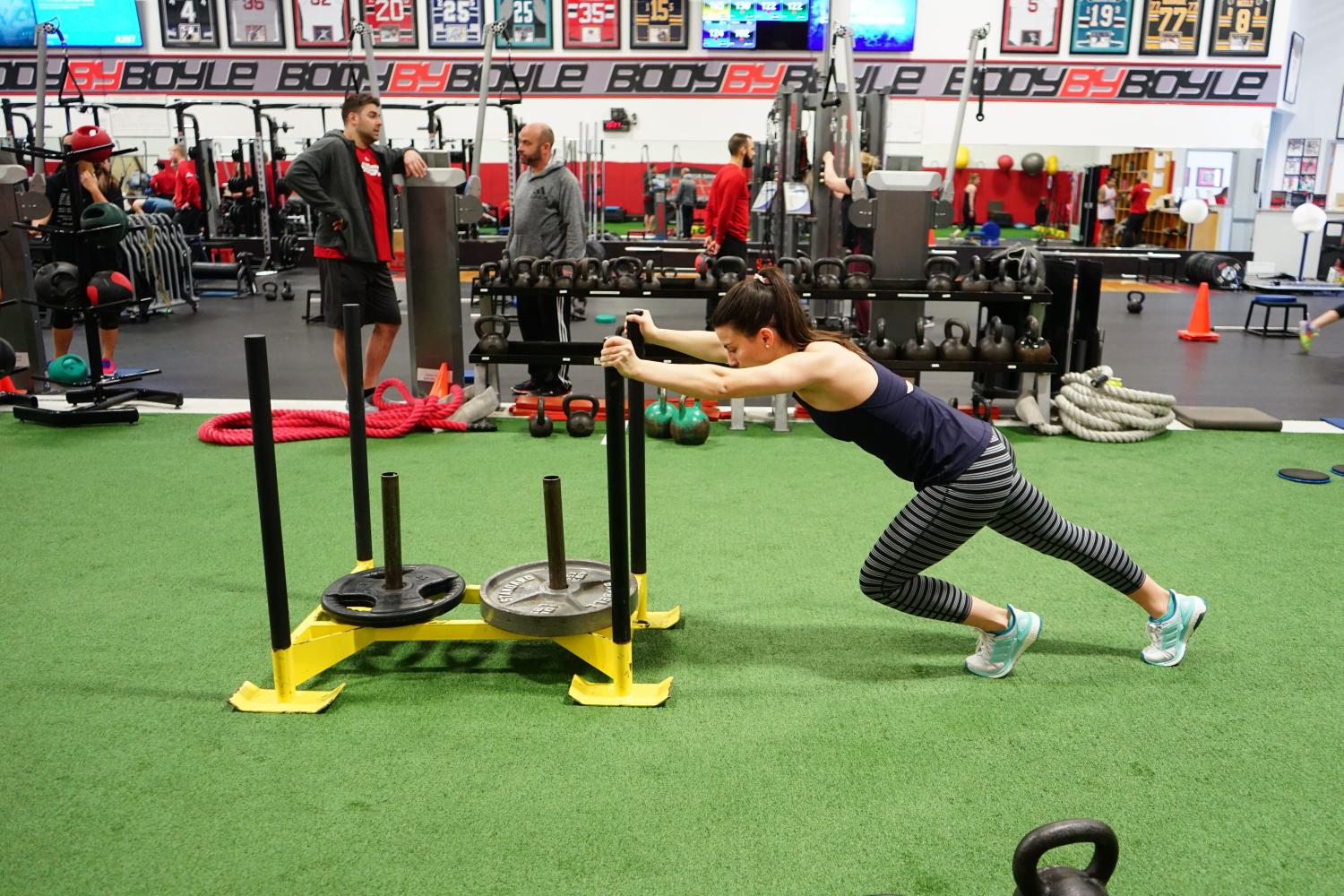
Want to learn how your fitness business can take it to the next level? Get a demo now!









